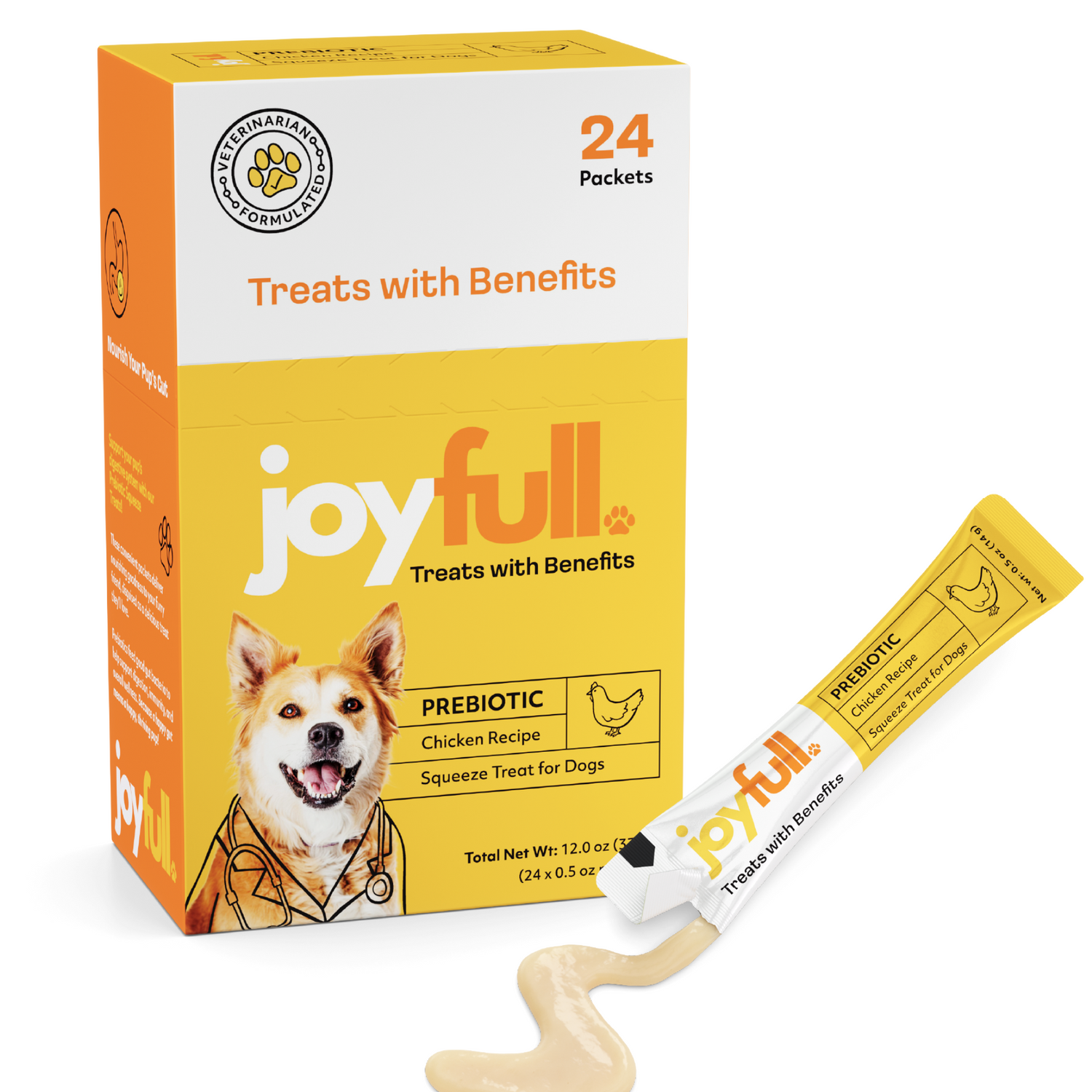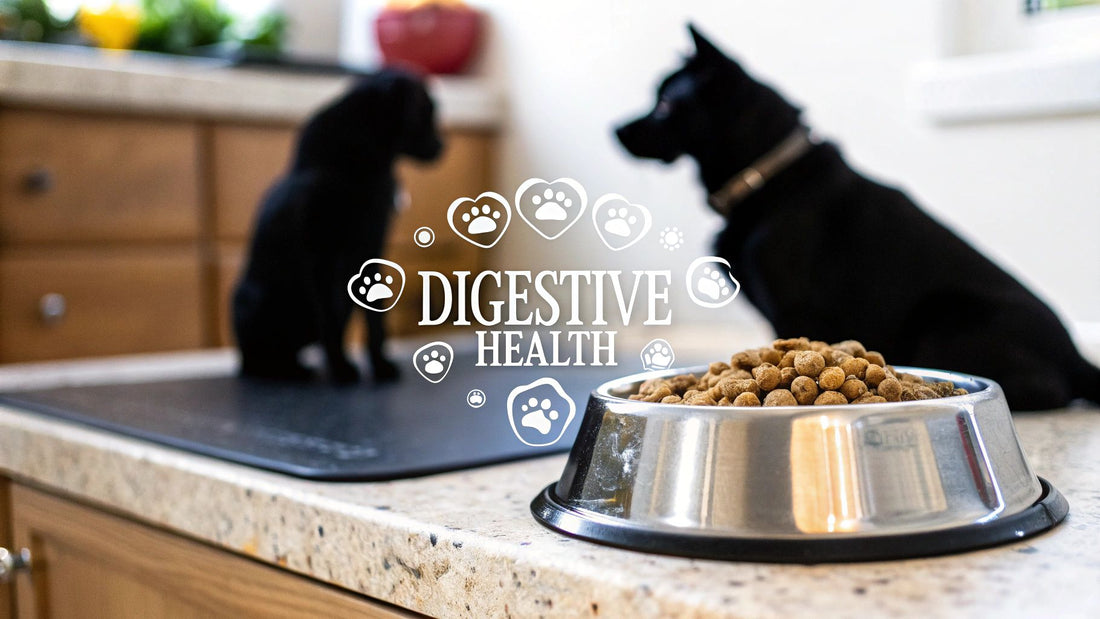
Best Dog Food for Digestive Health
The best dog food for good digestion isn't just about one magic ingredient. It's about a smart combination of highly digestible proteins, the right mix of soluble and insoluble fibers, and gut-friendly extras like probiotics and prebiotics. When these elements work in harmony, they create the perfect conditions for smooth digestion, maximum nutrient absorption, and a happy, balanced gut for your pup.
A Look Inside Your Dog's Digestive System
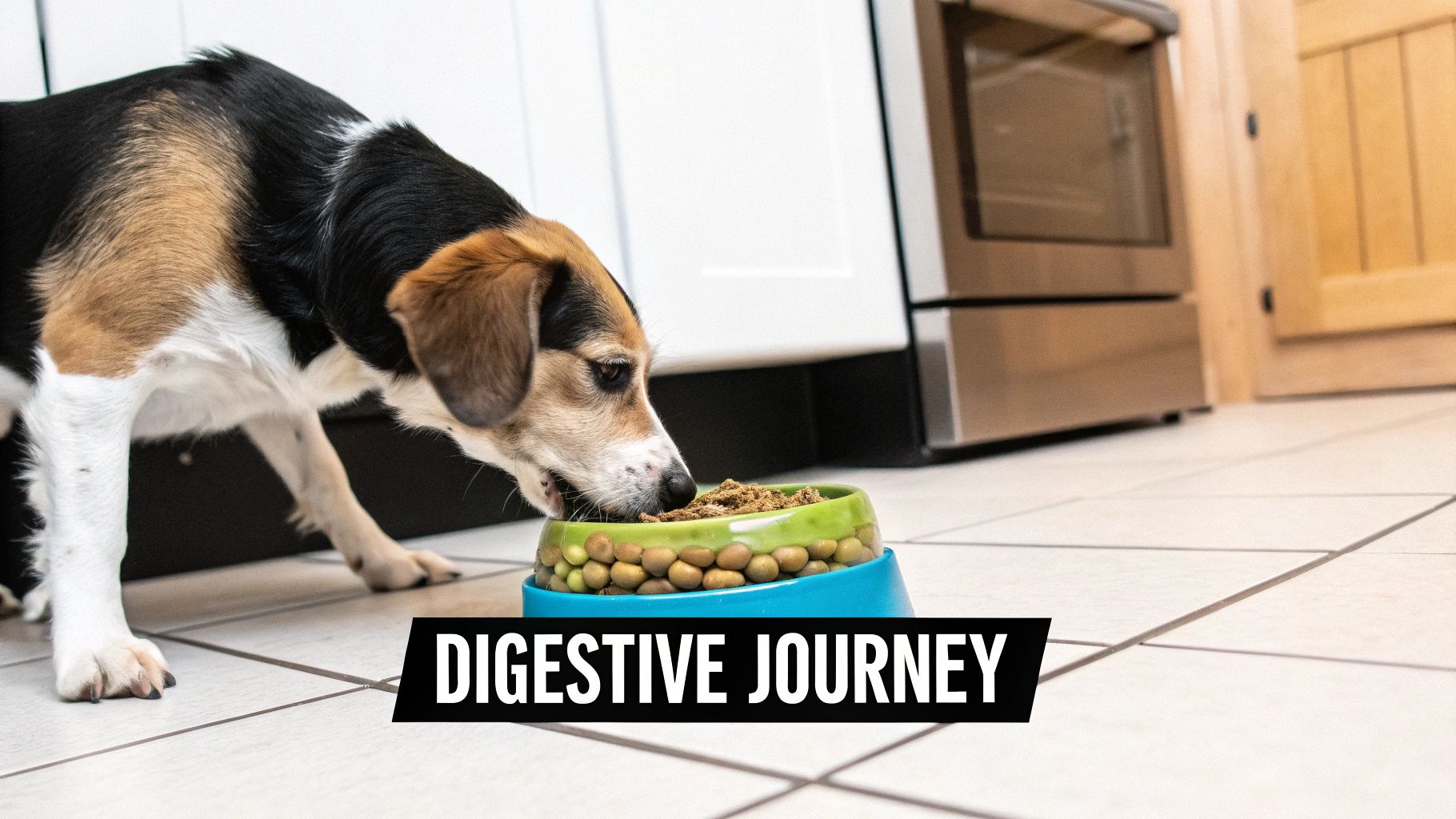
Before you can pick the right food, it helps to know what’s going on under the hood. Your dog's digestive system is like a finely tuned engine, specifically built to turn meals into energy, healthy muscle, and pure vitality. Understanding how this internal engine works is the first step in giving it the high-quality fuel it needs to run smoothly.
The process kicks off the second food hits their mouth. From there, it heads down to the stomach, a highly acidic environment designed to start breaking down proteins and knock out any nasty bacteria. This is the first, crucial stop.
The Intestines: Where the Real Work Happens
After the stomach has done its part, the now-mushy food mix moves into the small intestine. This is where the magic really happens—it’s the main hub for nutrient absorption. Here, specialized digestive enzymes get to work, dismantling fats, proteins, and carbs into tiny molecules the body can actually use.
The walls of the small intestine are covered in microscopic, finger-like structures called villi, which create a massive surface area to soak up all that goodness. If this lining isn't healthy, even the most expensive food can pass right through without delivering its benefits.
The Gut Microbiome: Your Dog's Inner Garden
Whatever is left over makes its way to the large intestine, which is home to trillions of microorganisms—the gut microbiome. This bustling community of bacteria isn't just along for the ride; it's absolutely essential to your dog's overall health.
A dog’s digestive system is incredibly short and designed to process nutrient-dense foods quickly. This is why highly processed diets loaded with fillers can cause issues like bloating and gas, as they aren't what their system is built to handle efficiently.
This inner ecosystem helps break down fiber, synthesizes important vitamins, and even supports the immune system. When the good bacteria are thriving, you’ve got the foundation for fantastic digestive health. But if things get out of balance, you'll start seeing problems like gas, diarrhea, and general discomfort.
Knowing how this whole system works—from the stomach's acid bath to the microbiome's delicate balance—makes finding the best dog food for digestive health feel a lot less like guesswork.
Key Ingredients for a Happy Gut
Trying to read a dog food label can feel like you're trying to crack a secret code. To find the best food for your dog's digestive health, you have to look past the flashy marketing claims and focus on the ingredients that really work to support their gut from the inside out.
The right formula isn't just about preventing an upset stomach; it's about building an internal ecosystem where your dog can truly thrive. This all starts with high-quality, easily digestible proteins. Ingredients like chicken, lamb, and fish are fantastic because they provide the essential amino acids your dog needs without making their digestive system work overtime. The result? More nutrients get absorbed, and less waste comes out the other end.
This infographic breaks down some of the best fresh ingredients that help build a healthy gut.
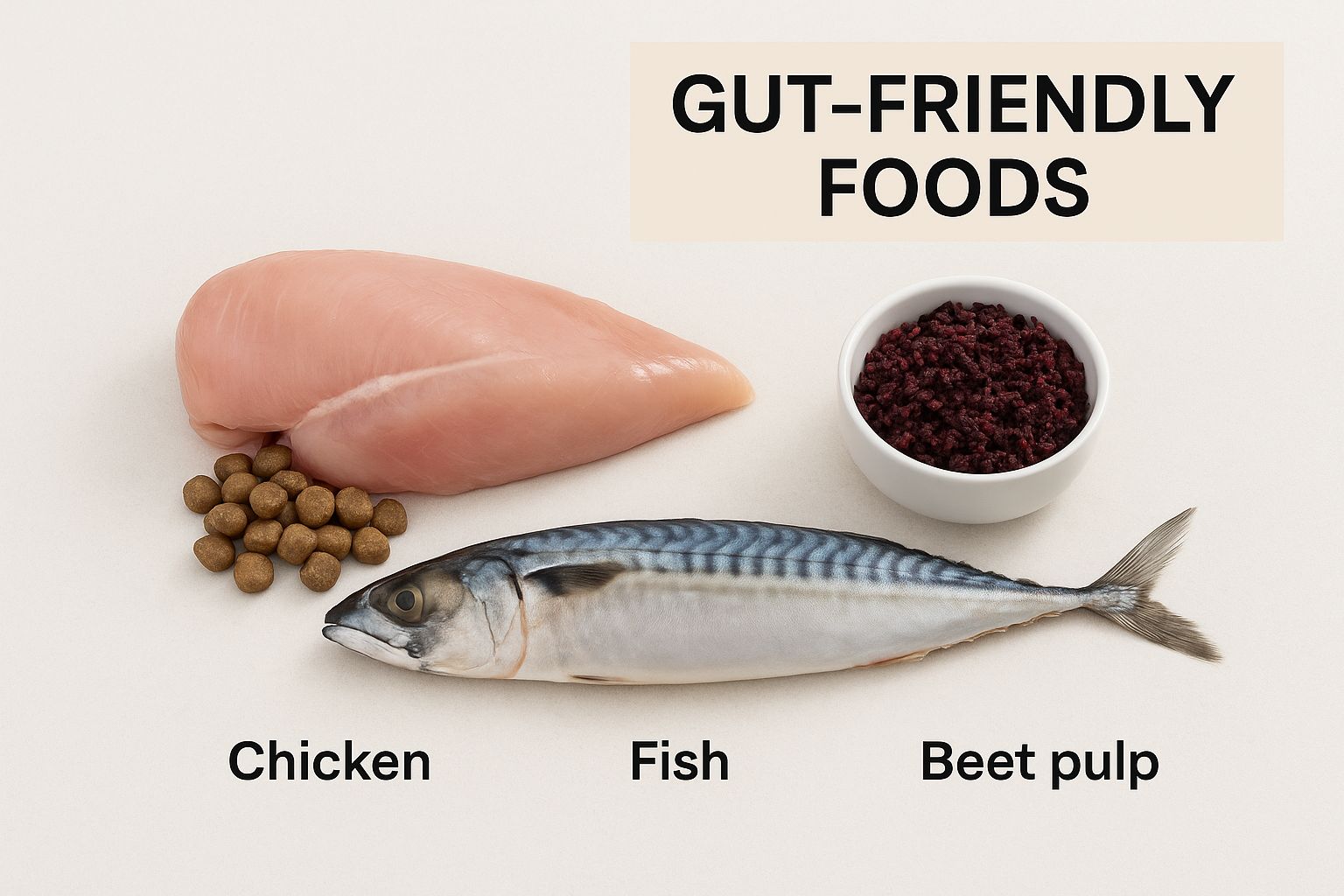
As you can see, the foundation of a diet built for digestive wellness is a smart combination of quality proteins and functional fibers.
The Dynamic Duo of Fiber
Fiber is so much more than just filler. It plays a critical, two-part role in keeping your dog's digestive system running smoothly. Think of it as the gut's traffic controller, managing the speed and quality of everything passing through.
There are two types you should know about:
- Soluble Fiber: This type dissolves in water, creating a gel-like substance in the gut. Ingredients like pumpkin and beet pulp are great for slowing down digestion, which is incredibly helpful for firming up loose stools.
- Insoluble Fiber: This fiber doesn't dissolve. Instead, it adds bulk to the stool. Sources like psyllium husk help keep things moving, preventing constipation and ensuring your dog stays regular.
Having a balanced blend of both is the secret sauce for perfect poop. Research consistently shows that dietary fiber is vital for canine digestion. In fact, most formulas designed for digestive health contain between 3% and 7% crude fiber to get the job done right.
Nurturing the Gut Garden with Prebiotics and Probiotics
Beyond the basics of protein and fiber, a truly healthy gut relies on a flourishing community of beneficial bacteria—often called the microbiome. This is where prebiotics and probiotics enter the picture. They're a powerful team dedicated to keeping this internal "garden" balanced and healthy.
Prebiotics are essentially fertilizer for the good bacteria already living in your dog’s gut. They are special plant fibers, like fructooligosaccharides (FOS), that feed and encourage the growth of these helpful little microbes.
Probiotics, on the other hand, are the good bacteria themselves. Adding these live, beneficial organisms to your dog's diet helps reinforce their existing gut flora, which can crowd out harmful pathogens and even support their immune system.
Together, they create a powerful partnership that's fundamental to long-term digestive wellness. You can dive deeper into how they work in our guide to the best probiotics for dogs.
To help you spot these powerhouse ingredients on a label, here's a quick reference guide.
Digestive Health Superstars Ingredient Guide
| Ingredient Category | Primary Function | Common Examples |
|---|---|---|
| High-Quality Protein | Provides essential amino acids that are easy to digest and absorb. | Chicken, Lamb, Fish, Turkey |
| Soluble Fiber | Slows digestion to help firm up loose stool. | Pumpkin, Beet Pulp, Oats, Barley |
| Insoluble Fiber | Adds bulk to stool, promoting regularity and preventing constipation. | Brown Rice, Psyllium Husk, Cellulose |
| Prebiotics | Feeds the beneficial bacteria in the gut microbiome. | Fructooligosaccharides (FOS), Chicory Root |
| Probiotics | Introduces live, beneficial bacteria to support gut balance. | Lactobacillus acidophilus, Bifidobacterium animalis |
When you see a combination of high-quality proteins, a smart mix of fibers, and the inclusion of both prebiotics and probiotics, you can feel confident that you're holding a bag of food designed for a happy, healthy gut.
Ingredients to Avoid for Sensitive Stomachs
When you're trying to find the right food for a dog with a sensitive stomach, knowing what not to feed them is half the battle. Think of it this way: some ingredients are like roadblocks in your dog's digestive system, causing traffic jams that lead to gas, bloating, and general misery. Learning to sidestep these common culprits is one of the best things you can do for your dog's gut health.
A lot of dog foods on the market use inexpensive fillers to add bulk and keep costs down. Ingredients like corn, wheat, and soy are often at the top of this list. While they aren't toxic, their complex carbohydrates can be tough for some dogs to break down. When that happens, they can ferment in the gut, which is a recipe for gas and inflammation. Plus, they just don't pack the same nutritional punch as high-quality animal proteins.
You also want to be a bit of a detective when you see vague terms on the label, like "meat by-products" or "animal digest." This is often a catch-all for rendered animal parts that can be much harder to digest and offer lower nutritional quality than clean, specified muscle meat. A food you can trust will be specific, listing ingredients like "deboned chicken" or "lamb meal" right on the front.
Spotting Hidden Troublemakers on the Label
Beyond the obvious fillers and mystery meats, artificial additives are another major source of digestive upset. These are usually thrown in to make the food look or taste better to us (or the dog) or to give it a longer shelf life, but they bring nothing good to the table nutritionally.
Here are a few common ones to keep an eye out for:
- Artificial Colors: Things like Red 40, Blue 2, and Yellow 5 have no purpose other than aesthetics. For some dogs, they can trigger allergic reactions and stomach issues. A food’s color should come from its real ingredients, not a chemical dye.
- Artificial Flavors: If a food needs an artificial boost to taste good, it’s often a red flag that the core ingredients aren't that great to begin with.
- Artificial Preservatives: Chemicals like BHA, BHT, and ethoxyquin are effective at preventing spoilage, but they can be harsh. I always recommend looking for foods that use natural preservatives instead, like mixed tocopherols, which is just a form of Vitamin E.
These synthetic additives can really irritate the gut, throwing the whole system out of whack.
I often tell my clients to think of a dog's gut as a delicate ecosystem, like a pristine lake. Tossing in artificial chemicals is like pouring pollutants into the water. It disrupts the natural balance and can harm the "inhabitants"—in this case, the good bacteria that are crucial for healthy digestion.
Once you get the hang of spotting these red-flag ingredients, you'll feel much more confident choosing a food that truly nourishes your dog instead of just filling their bowl. It really comes down to finding clean, whole-food ingredients that your dog's body was actually built to handle. A clean, simple ingredient list is almost always the first sign of a high-quality, easily digestible food.
How JoyFull Puts Gut Health Science Into Practice
Knowing the science behind your dog's digestion is one thing, but seeing it work in their food bowl is what really matters. At JoyFull, we don't just nod along to the research—we build every single recipe around it. Our formulas are a direct result of everything we know a sensitive stomach needs to thrive. We’ve turned the theory into a tangible, bowl-licking solution.
It all starts with the number one ingredient: protein. You won't find vague "meat meals" or plant proteins that can be tough on a dog's system. Instead, we focus on premium, single-source animal proteins, like cage-free chicken or wild-caught salmon. This strategy drastically reduces the chances of triggering a food sensitivity and makes the protein incredibly easy for your dog to absorb, meaning they get more nutrients with less digestive strain.
The Perfect Balance of Key Ingredients
Great protein is just the start. We know that the right kind of fiber is the secret to perfect poop and a happy tummy. That’s why our formulas contain a carefully measured mix of both soluble and insoluble fibers. This is where ingredients like pumpkin and beet pulp shine.
Think of it this way:
- Soluble fiber from ingredients like pumpkin is like a sponge. It soaks up extra water in the gut to help firm up loose stools.
- Insoluble fiber provides gentle bulk, which keeps everything moving along smoothly to prevent constipation.
This one-two punch ensures digestive "traffic" moves at just the right speed. The result is a comfortable, predictable system for your dog.
We’ve always believed that what goes into the bag is a direct reflection of the results you’ll see in your dog. By focusing on whole-food ingredients and scientifically proven gut support, we’re not just offering a quick fix—we’re building a foundation for a lifetime of digestive wellness.
Going a Step Further for the Gut Microbiome
Finally, we get down to the microscopic level and focus on that delicate ecosystem inside your dog's gut—the microbiome. For a gut to be healthy, it needs a thriving army of good bacteria. That's why every single bag of JoyFull comes with guaranteed live probiotics. These beneficial little organisms get to work balancing the gut environment, helping to push out bad bacteria and improve how well your dog absorbs nutrients.
But we don't stop there. To make sure those good bacteria have everything they need to flourish, we add prebiotics like chicory root. Prebiotics are essentially food for probiotics, ensuring the good guys are well-fed and ready to do their job.
This complete, thoughtful approach is what makes our recipes one of the best dog food for digestive health options you can find. By bringing together easily digestible proteins, a precise fiber blend, and active gut support, JoyFull offers a truly holistic solution designed to soothe sensitive stomachs and build lasting wellness from the inside out.
Practical Feeding Tips for Digestive Wellness
Picking the right food is a massive win for your dog's digestive health, but how you feed them is just as crucial. Even the best formula can cause an upset stomach if your feeding habits aren't quite right. A consistent routine helps your dog's gut operate like a well-oiled machine.
Think of their digestive system as a factory that thrives on a predictable schedule. When you feed your dog at the same times every day, their body learns to anticipate the meal and gets the necessary digestive enzymes and acids ready to go. This rhythm helps prevent the system from getting overloaded, which means smoother digestion and more efficient nutrient absorption.
Portion control is another big piece of the puzzle. Giving your dog too much food at once can overwhelm their stomach's ability to break it all down, leading to indigestion and bloating. The feeding guidelines on the bag are a solid starting point, but remember to tweak the amount based on your dog's specific age, activity level, and overall condition.
The Art of a Slow Food Transition
One of the most common culprits behind digestive upset is switching foods too quickly. An abrupt change can be a real shock to their gut microbiome, leading to gas, diarrhea, or vomiting as the system scrambles to adapt. A slow, methodical transition is the only way to go.
A proper switch should take at least 7 to 10 days. This process gives the good bacteria in your dog's gut enough time to get used to the new ingredients. For a detailed breakdown, we’ve put together a guide on how to transition your dog to a new food.
The goal isn't just to get them to eat the new food; it's to retrain their entire digestive ecosystem without causing disruption. Patience during this period pays off with long-term digestive peace.
Simple Habits for a Healthier Gut
Beyond schedules and food transitions, a few other simple habits can make a world of difference for your dog's digestive wellness.
- Always Provide Fresh Water: Proper hydration is absolutely essential for digestion. Water helps break down food and transport nutrients where they need to go. Make sure a clean bowl of fresh water is always within reach.
- Consider Your Feeding Tools: Believe it or not, the bowl matters! If you have a dog that inhales their food, a slow-feeder bowl can be a game-changer. It forces them to slow down, which prevents them from swallowing a lot of air and reduces gas. Even little things like choosing the right feeding bowls can support much healthier eating habits.
When you pair a high-quality diet with these thoughtful feeding practices, you create a complete support system for your dog's gut, ensuring they feel fantastic from the inside out.
Common Signs of Poor Digestive Health
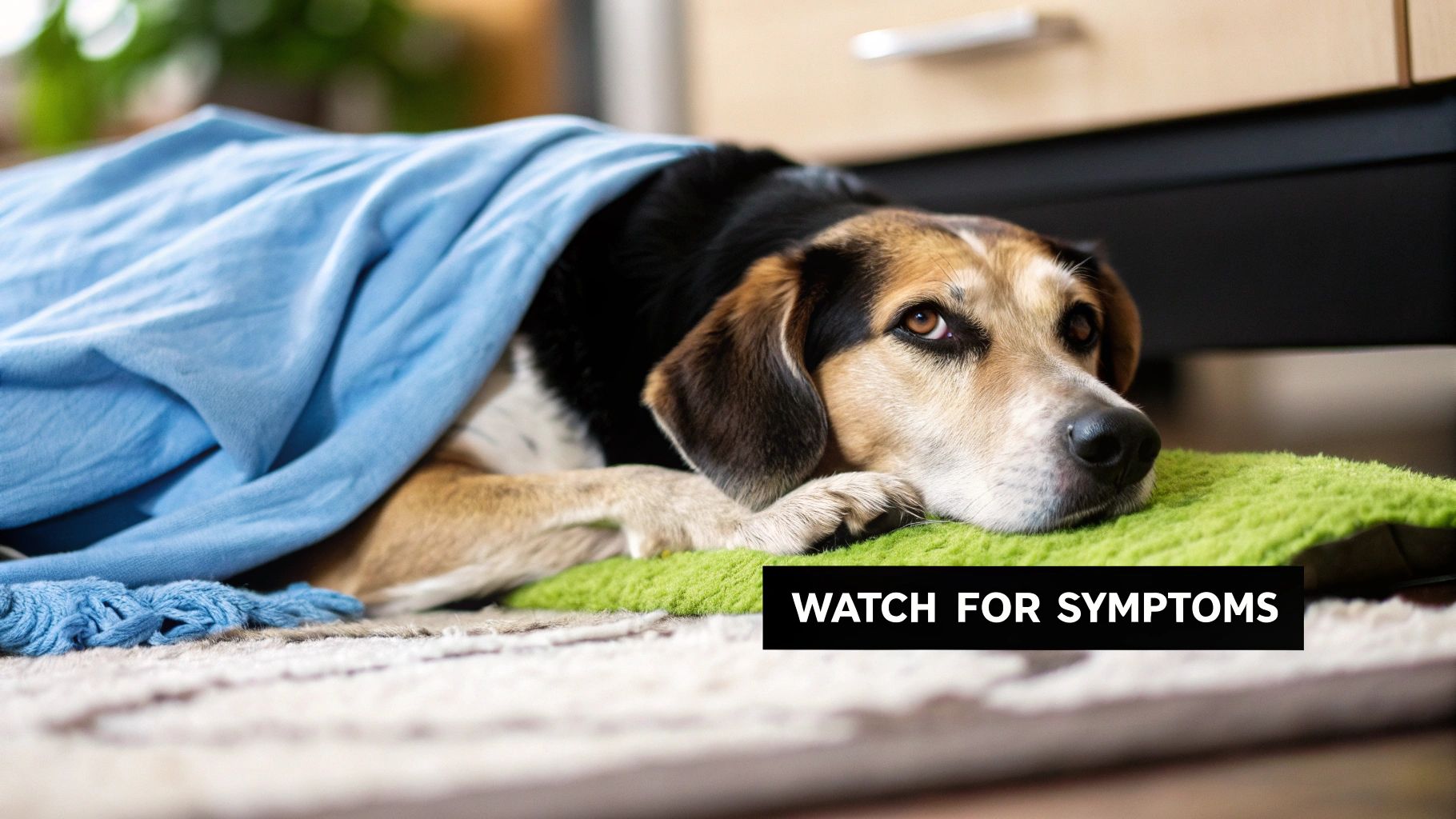
The first step in helping your dog feel their best is knowing how to spot trouble in the first place. When it comes to their digestive system, some red flags are obvious, but others are much more subtle. Being able to recognize the full spectrum of signs lets you get ahead of problems before they escalate.
The most glaring signs are, well, impossible to ignore. We're talking about things like chronic diarrhea, frequent vomiting, and excessive gas. These are your dog's gut telling you loud and clear that something isn't being processed correctly. If your dog’s gassiness is a frequent issue, you can learn more about the potential causes here.
Subtle Clues to Watch For
But digestive trouble isn't always about a noisy or upset stomach. Sometimes, the clues are quieter and easy to write off as something else.
- Dull Coat and Skin Issues: When your dog can't absorb all the good stuff from their food, their skin and coat are often the first places you'll see it. A lackluster coat or flaky skin can be a direct result of poor nutrient uptake.
- Lethargy or Low Energy: Think of it like a car running on low-quality fuel. If your dog isn't getting the right nutrients, their energy levels will naturally take a nosedive.
- Changes in Appetite: A sudden disinterest in food—or the opposite, a dog who seems ravenous all the time—can signal that something is off in their digestive tract.
An occasional upset stomach is one thing, but if you're seeing these symptoms consistently, it’s time to call the vet. They are your best resource for ruling out any serious health conditions and figuring out if a simple diet change is the right next move.
For more hands-on advice, this guide on managing dog diarrhea and vomiting offers some great, practical insights.
Your Top Questions About Dog Digestion, Answered
When you're trying to nail down the right diet for your dog, questions are bound to come up. It's totally normal. To help you out, we've tackled some of the most common things pet parents wonder about when looking for the best dog food for digestive health.
Getting a handle on these topics will help you feel much more confident in the choices you're making for your best friend.
How Long Does It Take to See a Difference After Switching Food?
While you might see firmer, healthier stools in just a few days, a dog's gut needs time to fully get on board with a new menu. Expect a full adjustment period of anywhere from 2 to 8 weeks.
The key is a slow and steady transition over 7-10 days to avoid any tummy troubles. After about a month, you'll likely start noticing the bigger perks—like a shinier coat, more playful energy, and truly consistent digestive health as their system really settles in.
Is a Grain-Free Diet Really Better for My Dog's Digestion?
This is a big one, and the answer is usually no. For most dogs, digestive upset isn't caused by grains themselves, but by the overall quality of the ingredients in their bowl. True grain allergies are actually pretty rare and need to be diagnosed by your vet.
In reality, wholesome grains like brown rice or oatmeal are fantastic sources of fiber. They feed the good bacteria in your dog's gut and provide essential nutrients that contribute to great health.
Instead of just cutting out an entire food group, the focus should be on choosing a food made with high-quality, easily digestible ingredients. A well-made recipe that includes quality grains is almost always a better choice than a low-quality grain-free formula.
Can I Give My Dog "People Food" to Help Their Tummy?
It's tempting to share, but you have to be careful. A small dollop of plain, unsweetened pumpkin puree or a little plain yogurt can sometimes help soothe a dog's stomach. However, a lot of what's in our kitchens can cause serious problems.
Table scraps are a definite no-go. Anything fatty, salty, or seasoned is a recipe for digestive disaster. Before you add anything new to your dog’s bowl, it's always best to get a quick "okay" from your veterinarian to make sure it's safe and right for your individual dog.
Ready to build a foundation of wellness from the inside out? Discover how JoyFull's science-backed formulas can support a happy, healthy gut. Explore our recipes to find the perfect fit for your dog.
